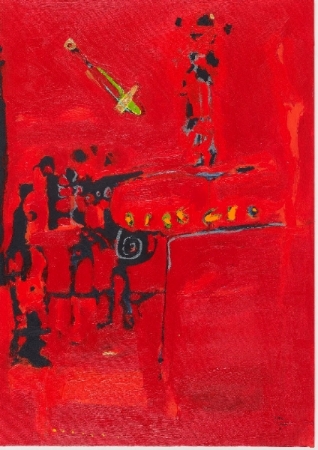
Olga Dengo shows new work at Galerie 23 in Amsterdam till September 7.
Together, 2013-2014.
About:
Memories, 2013-2014.
Born in 1980 in Mozambique, artist Olga Dengo has been painting professionally for the last 12 years. She studied art in the Netherlands where she lived for 2 years as a teenager.
Her home base in Mozambique is Maputo, the capital of Mozambique. She is an active member of the National Mozambican Artist Association “Nucléo de Arte” where Master painter Malangatane is one of her colleagues.
Through the years, Olga achieved a certain reputation in her country and although she is still young of age she was already nominated “Personality of the Year 2005” in the category Fine Arts by the National Television.
Projects and research brought her to Sarajevo, Lebanon, Pakistan, Indonesia. Her paintings can be found in several private collections in Portugal, Switzerland, Denmark, the Netherlands, Belgium, United States, Great-Brittan, South Africa, Angola, Nigeria en Zimbabwe.
 Inside Yorself, 2009.
Inside Yorself, 2009.
Since her move to Belgium in May 2006, Olga has her studio in Antwerp and participated in many exhibitions and projects. One of her paintings on racism is exposed in the Belgian Senate.
Her work is abstract, expressionistic, colourful and inspired by the strong contrasts in today’s world. Her style cannot be easily put in one of the categories of the Western focused contemporary art scene of Europe or America. In some way this is normal because contemporary art from outside the EU or US has a different origin and a different evolution.
Her work shows a strong political engagement and social awareness. There is always a strong but positive critic on society and an advice to admit more colours into life. Her work is often a slap in the face and a call to wake us up from the comfort of our luxury. With her paintings the artist tries to break open the minds and visions of people, rocked asleep by well-being. Allowing but not fearing the unknown and having the courage to raise your voice and do something.
 Replacing the Emptiness, 2008.
Replacing the Emptiness, 2008.
Inspiration comes from a wide variety of observations: a complaint against the speed of time, the beauty of a butterfly, hypocrisy and snobbism, a scream against racism. The artist also tries to change the archaic preconceptions about modern art from her country and continent. Besides that, she pleas strongly for more respect for female artists.
Her work has been described by Prof Patrice of the Mozambican Arts Academy (translated from French):
« Olga Dengo is an artist painter with a strong reputation in her country and at the international level. Midway between lyric abstraction and figurative expressionism, she paints a vividly coloured œuvre in line with her interior feelings or the events of the day. One could recognise some elements of decorative African art in traces or collages. Fragments of printed tissue surrounded by layers of black paint with a rich texture. Faces, fragments of bodies, portraits and texts appear as graffiti, showing an extremely lively art. Without any doubt the viewer escapes from the sombreness and experiences the satisfaction of entering a universe that is personal and collective in the same time, witnessing an urban painting culture that has nothing to do with easy exotism. “
 Red, 2012.
Red, 2012.
By others her style has been linked to Miró and Jean-Michel Basquiat. (Rob Perrée, November 2007, translated from Dutch, ): “She moves between abstraction and figuration. Some works are limited to a number of round forms on a monochrome canvas. Those paintings are associated with the empty paintings of the Spanish artist Juan Miro. The play of colours, the way different forms relate to each other and the way they are put into space. In other pieces, these forms are assembled into a composition that reminds me of human figures. Colours keep on playing an important role, but here they get a more symbolic meaning because they are linked to a head or a body. I qualify them as “happy”, “deceived”, “intense” or “warm”. Sometimes, her style gets looser, more expressionistic. Colours continue to be contrasting. Lots of black, lots of red. Miro changes here more and more into Cobra. Other times, Dengo seems not to be satisfied with forms or colours and images alone. Texts appear on the canvas. Words and sentences, shouting for attention. Although Miro also complemented his paintings with short texts, the ones of Dengo remind me more of the rapidly written poetic sentences of Jean-Michel Basquiat”.
(text from her website)


